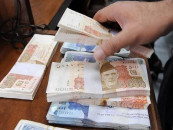Govt expenditure stands at Rs4.8tr
Expenses fuelled by interest costs, other spending

The federal government’s expenditure surged to Rs4.83 trillion in five months due to an unmanageable interest cost and a slight opening of the public purse for other spending, raising questions about claims of achieving fiscal consolidation.
Finance Ministry sources revealed that the tight control maintained over expenditures until October was slightly relaxed last month, resulting in about a Rs580 billion jump in the federal budget deficit in just one month.
During the July-November period of this fiscal year, total federal government expenses rose to Rs4.83 trillion, marking an increase of nearly Rs1.5 trillion or 43% compared to the same period last fiscal year.
November unravelled the positive impact of the bullet profit payment by the State Bank of Pakistan (SBP), which had kept the deficit in check despite high-interest costs.
Current expenditures amounted to over Rs4.7 trillion in five months, a 45% increase or Rs1.47 trillion compared to the previous year. The pace of increase in current expenditures is higher than the prevailing inflation rate of 29%, undermining claims of achieving fiscal sustainability.
The Ministry of Finance claimed this week that the government had managed to bring the fiscal and current account deficits under control, laying the foundation for sustainable economic growth. However, sources attribute the 43% increase in overall expenditure to the interest payments on the stock of about Rs65 trillion government debt. Interest payments during July-November skyrocketed to Rs2.92 trillion, a 75% increase compared to the same period last fiscal year.
Pakistan cannot progress economically until it addresses the high cost of debt servicing, triggered by the record-high interest rate of 22% maintained by the central bank. The beneficiaries of this policy are commercial banks poised to make over Rs1 trillion in profits this year, almost double that of the last year.
Interest payments of Rs2.92 trillion were equal to 40% of the annual allocated budget of Rs7.3 trillion. The finance ministry had deliberately understated the interest cost in June’s budget, feared to exceed the ceiling by over Rs1.2 trillion.
The five-month interest cost consumed 87% of the net federal income of Rs3.3 trillion during the period under review. Defence spending was in line with the annual budget, standing at nearly Rs600 billion or one-third of the annual allocation.
Read LCCI explores implications of federal budget 2023-24
It appears the military is managing its books far better than the federal government.
The federal government’s net income of Rs3.34 trillion in five months was roughly Rs170 billion less than the combined expenditure on interest payments and defence.
Development spending saw a small uptick in November, reaching Rs120 billion but still 8% less than the same period last fiscal year.
The IMF has projected Pakistan’s budget deficit at 7.6% of the size of its economy, or a record Rs8.2 trillion, far higher than the official target. This would keep the government dependent on lenders to remain afloat. The 7.6% deficit means that Pakistan will need to borrow Rs1.3 trillion more than planned in June this year.
The government’s other expenditures also started showing an increase, standing at Rs1.2 trillion in five months.
The exceptional performance by the Federal Board of Revenue (FBR) and one-off bullet payments has helped achieve over 50% increases in the government’s gross revenues during July-November. FBR pooled nearly Rs3.5 trillion in five months, maintaining growth equal to the inflation rate.
The Centre’s non-tax income rose to Rs1.75 trillion during the first five months, equal to 60% of the annual target after the federal government decided to tap SBP profits beforehand.
The central bank injection had helped restrict the federal budget deficit to Rs900 billion or 0.9% of the size of the economy during the first four months. But this trend reversed in November.
The federal budget deficit rose to Rs1.5 trillion in five months, higher by 8% over the previous fiscal year. It still seems within the annual range of Rs75 trillion, although the IMF has already projected an overshoot of Rs1.2 trillion. The federal budget deficit was equal to 1.4% of the GDP.
The provinces remain the weakest link in the country’s fiscal operations and also a reason for its lowest tax-to-GDP ratio.
The first five months trend showed that the provincial governments may not be able to show Rs600 billion cash surpluses needed to achieve the IMF’s primary budget surplus target.
The combined cash surplus shown by the provinces amounted to Rs108 billion in five months, nearly 50% less than the same period of the last fiscal year.
The government took Rs1.1 trillion loans from the domestic market and borrowed Rs300 billion from foreign lenders to bridge the budget deficit.
The gross federal government borrowings from the banks were Rs2.3 trillion, and it used the rest of the amount to retire loans from non-banking lenders, leaving virtually nothing for the private sector to borrow.
Published in The Express Tribune, December 31st, 2023.
Like Business on Facebook, follow @TribuneBiz on Twitter to stay informed and join in the conversation.


















COMMENTS
Comments are moderated and generally will be posted if they are on-topic and not abusive.
For more information, please see our Comments FAQ